11 April 2025
Weekly Market View
Time for bargain hunting, not for selling
Risk assets gyrated this week after US President Trump paused reciprocal tariffs on over 75 countries for 90 days, while escalating tariffs against China.
The volatility shows policy uncertainty, not fundamentals, remains the biggest overhang on markets. In these times, it’s worth repeating: “Time in the market is more important than timing the market”.
Apart from the safe-havens such as the CHF, JPY and government bonds, conservative and balanced asset allocation strategies have helped investors ride out the latest storm with relatively low volatility, underscoring the benefit of a sound foundation portfolio.
As Wednesday’s sharp bounce showed, investors risk missing out on some of the best days of the equity market, hurting long-term returns, if they sell or remain on the sidelines.
Sharp drawdowns in risk assets are presenting some bargains in our preferred sectors. We add US inflation-protected government bonds as a hedge against tariff-driven inflation. Gold remains a hedge against stagflation risks.
Where are the opportunities in equities now?
How can I protect my portfolio?
Can the JPY and CHF extend gains on safe-haven demand?
Charts of the week: Staying invested and well diversified
Diversified conservative and balanced strategies have performed well during the latest market turmoil
Performance of assets since ‘Liberation Day’, 2 to 9 April
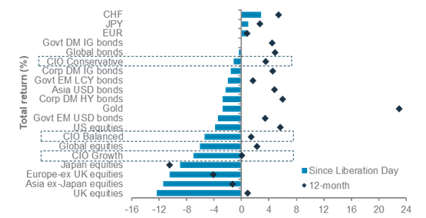
S&P500 median return in recession/no-recession periods*

Source: Bloomberg, Standard Chartered; *Based on historical 9-month returns after at least 10% drawdown from peaks since 1970s
Editorial
Time for bargain hunting, not for selling
Risk assets gyrated wildly this week after US President Trump paused reciprocal tariffs on over 75 countries for 90 days, while escalating tariffs against China. The volatility shows policy uncertainty, not fundamentals, remains the biggest overhang on markets. In these times, it’s worth repeating the adage: “Time in the market is more important than timing the market”.
Apart from the safe-havens such as the CHF, JPY and government bonds, conservative and balanced asset allocation strategies have helped investors ride out the latest storm with relatively low volatility, underscoring the benefit of a sound foundation portfolio. Alternative strategies offer low volatility as well. As Wednesday’s sharp bounce showed, investors risk missing out on some of the best days of the equity market, hurting long-term returns, if they sell or remain on the sidelines. As markets get whipsawed, sharp drawdowns in risk assets are presenting some bargains in our preferred sectors. We add US inflation-protected government bonds as a hedge against tariff-driven inflation. Gold remains a hedge against stagflation risks.
Still about tariffs, not fundamentals: The flip-flop in US trade policy remains the primary driver of markets. The uncertainty overshadowed a still-resilient US job market. The focus now turns to negotiations with key trade partners, with Japan, South Korea, Vietnam and India reportedly among the first in the queue. However, the trade war with China has escalated and developments here will be increasingly important.
Base scenario: We expect an economic soft landing as Trump bows to investor/voter pressure and seals deals with key trade partners. This week’s volatility, followed by the policy U-turn, underscores the “Trump put”. In this scenario, growth falls below trend, but the US avoids a recession as the Fed cuts rates by 50bps in H2. Meanwhile, focus shifts to tax cuts and deregulation, helping risk assets recover by year-end. Under this scenario*, the S&P500 index is expected to end the year around 6,200 and the US 10-year bond yield around 4.0-4.5%.
Downside risks: There is a rising risk of slower growth and higher inflation if negotiations fail and some tariffs come into effect. The Yale Budget Lab estimates that the “Liberation Day” tariffs (if they are reimposed) would raise average US tariff to 22.5%, the highest since 1909. The short-run impact would be a 2.3% additional rise in US consumer prices, 0.9 percentage point (ppt) cutback in GDP growth and 0.5ppt rise in unemployment rate (see chart in page 3 for details).
The spillover effect: The impact of higher US tariffs on inflation, consumer and business confidence, job markets and corporate earnings (watch upcoming earnings) could lead to a mild recession as the Fed holds off rate cuts due to near-term inflation spike. In this scenario, the S&P500 index is likely to retest the key level of 5,000, the US 10-year yield at 2.5-3.0% and the USD index falls below its three-year range, below 100, especially if the rest of the world avoids a recession. A 5-10% managed depreciation of the CNY is an upside risk for the USD, especially if other Asian currencies also depreciate.
Upside risks: Successful tariff negotiations and monetary and fiscal policy stimulus in China and Europe are possible catalysts for upside to risk assets. US policymakers then shift focus to tax cuts and deregulation, while China’s top policymakers boost domestic consumption and cut lending rates and bank reserve requirements. In Europe, Germany’s incoming government could decisively boost fiscal policy, lifting Euro area’s potential growth outlook. In this scenario, the S&P500 index ends the year around 6,650, the US 10-year yield between 4.5-5.0% and the USD falls as non-US growth improves.
Time to hunt for bargains: Given our base scenario of an economic soft landing, we would look to add to our preferred sectors within a diversified allocation on pullbacks. These include: in the US, software and communication services (pricing power) and banking (deregulation); in Europe, banking (domestic driven) and industrial (fiscal support); and, in China, high dividend paying, non-financial state-owned enterprise and Hang Seng technology sectors (policy support) (see page 7).
The weekly macro balance sheet
Our weekly net assessment: On balance, we see the past week’s data and policy as neutral for risk assets in the near-term
(+) factors: Softer US inflation, easing global tariff risks
(-) factors: China deflationary pressures, rising US-China tensions
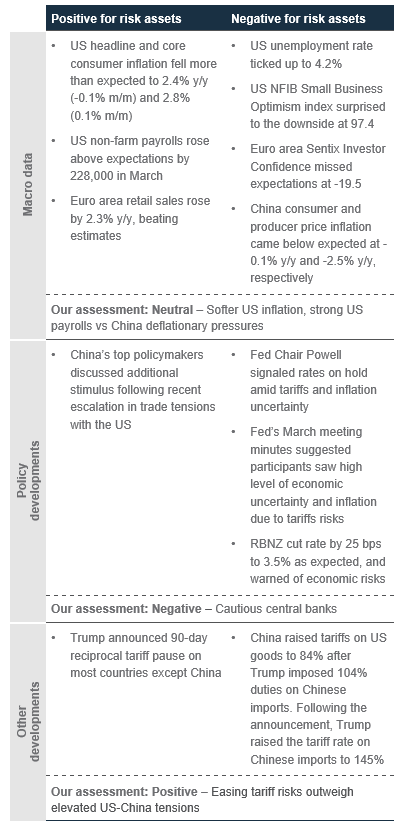
US job market remained resilient before the latest tariffs, while small business optimism has waned
US non-farm payrolls, NFIB Small Business Optimism index
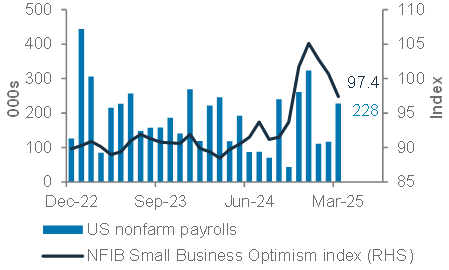
“Liberation Day” tariffs are estimated to hurt Canada, US and China growth the most
Structural percentage point change in real GDP levels against baseline due to US 2025 tariffs implemented till 7 April
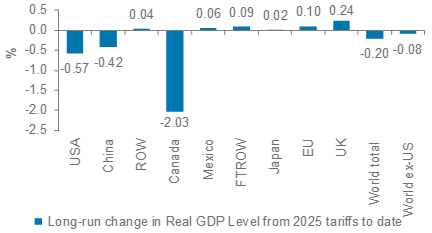
Source: Yale Budget Lab, Standard Chartered
China’s consumer and producer price deflation persisted in March
China consumer and producer price inflation
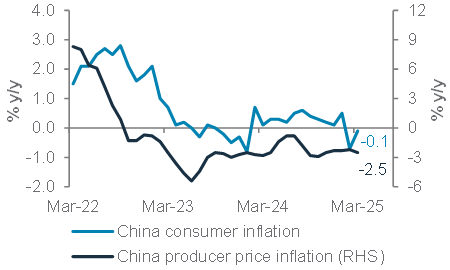
Source: Bloomberg, Standard Chartered
Top client questions
What is the risk-reward for US equities going forward after US tariffs pause?
The S&P 500 has risen 5.7% since Trump announced a 90-day pause on tariffs for most countries except China on Wednesday. This partially offsets the initial 19% drawdown in the S&P 500 this year. Looking into historical periods since 1970 when the S&P 500 fell by more than 10% from its peak show a 61% probability of gain by year-end, with this probability dropping to 46% under recessions. The year-end returns based on both mild-recession and non-recession periods average -5% and +12%, respectively, which roughly translate to a price range between 5,230 and 6,240. This range suggests an attractive risk-reward given the current level of the S&P 500 is 5,268.
Our indicators are currently also supportive of this bullish narrative. Our Fear and Greed Index is estimating a 73% probability for a bullish reversal to continue over the next three months as the market reaction in early April is deemed overly bearish following the US tariff announcements. The magnitude of the short-term sell-off is only exceeded by Black Friday in 1987, Global Financial Crisis in 2008 and COVID-19 in 2020. Meanwhile, our bull/bear market regime indicator, which turned bearish in early March, has been projecting a recovery at the end of April.
We believe global equities are likely to stay volatile in the near-term, with tariffs themselves and any retaliation and/or negotiation by US trade partners likely resulting in whip-shaw movements. If fully implemented, there is a risk US tariffs could push the economy into recession. However, we expect negotiations to limit the damage.
— Francis Lim, Senior Quantitative Strategist
Historical median returns for the S&P500 index post 10% drawdowns suggest a year-end range of 5,230 – 6,240
S&P 500 index
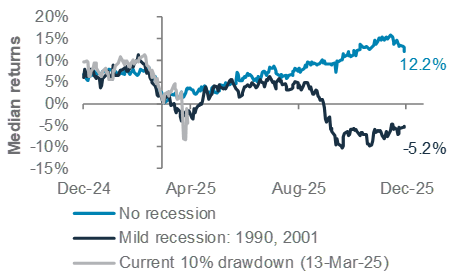
Source: Bloomberg, Standard Chartered; *Based on historical 9-month returns after at least 10% drawdown from peaks since 1970s
Top client questions (cont’d)
How many rate cuts do we expect? Is the Fed hamstrung by the inflationary impact of tariffs?
Clearly an inflationary environment makes the Fed’s job more challenging if growth falters. Therefore, the dramatic policy swings on tariffs over the course of the past week has made the future difficult to predict. Against this backdrop, markets have seen significant swings in the Fed rate cut outlook. At one point this week, markets were pricing in over 100bps in cuts by the end of the year. At the time of writing, they are pricing in about 75bps of cuts.
As far as the Fed is concerned, both Fed chair Powell and the FOMC minutes highlight the challenges of cutting interest rates in the face of rising inflation. Against that backdrop, the recent 90-day delay in the imposition of tariffs is a welcome development. It reduces the inflationary impulse considerably, while also being less of a headwind to growth, making the Fed’s job significantly easier, assuming the course is not reversed again.
Our view is the Fed will cut interest rates by 50bps in H2 2025. On the one hand, the labour market has been stronger than expected. On the other, heightened policy uncertainty may be a significant drag on both business investment and consumer spending.
— Ray Heung, Senior Investment Strategist
Money markets momentarily priced in 1% Fed rate cut by December and are currently pricing 75bps cut
Implied Fed funds rate by Dec 2025
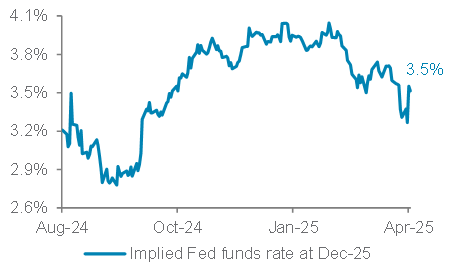
Source: Bloomberg, Standard Chartered
What might support a more sustained market recovery?
The key metric is the US 10-year government bond yield. Trump’s ultimate goal is to shrink the US budget deficit and a capped bond yield is part of his plan. After Liberation Day, stocks sold off sharply, but there was a flight for safety to US government bonds. Subsequently, we saw both stocks and bonds coming under pressure – with US 10-year yield up 70bps in 2.5 trading sessions. We believe this pressure has contributed to Trump’s “retreat” in his tariff stance to countries ex-China.
For the longer-term, greater clarity or reduced uncertainties regarding tariff policy would likely result in a more sustained recovery in equities and credit. A decrease in the 10-year bond yield back to our target range of 4.0% to 4.25% in the near term would also help restore confidence in the market. Additionally, the Fed’s actions to restore order in the bond market, similar to its intervention during the COVID-19 pandemic, may also improve sentiment.
— Daniel Lam, Head, Equity Strategy
— Ray Heung, Senior Investment Strategist
Top client questions (cont’d)
Can JPY and CHF extend gains on safe-haven demand?
The recent market focus on tariff news and economic growth concerns (rather than actual data prints) have exerted some selling pressure on the USD. Therefore, we see both the CHF and the JPY are likely to continue to gain on safe-haven demand, but to a different extent. USD/CHF appears oversold and the downside likely to be limited, with strong support at 0.8050. If global trade tensions continue to unwind, the pair is likely expose to a technical rebound with resistance at 0.8760. We expect volatility to remain high in the next two weeks.
Meanwhile, USD/JPY continues to come under downside pressure. The yen has outperformed most of its major peers, supported by strong safe-haven flows and a surge in bullish options exposure. The one-month USD/JPY risk reversals fell sharply and moved further into negative territory, reaching their lowest level since August 2024, signalling increased demand for downside protection in the options market.
USD/JPY one-month implied volatility has risen to over 13%, nearly two standard deviations above the one-year average. While the US has stated that trade negotiations with Japan will be prioritised, the process may take months to reach a deal. BOJ Governor Kazuo Ueda noted the central bank will closely monitor the impact of these trade measures and respond appropriately as needed. The pair is likely to test support at 139.5, while strong resistance stays at 150.8.
— Iris Yuen, Investment Strategist
We expect further USD/JPY downside towards 139.5
USD/JPY and technicals

Source: Bloomberg, Standard Chartered
Top client questions (cont’d)
Where are the opportunities in equities now?
While the level of tariffs continues to be negotiated, it seems clear that US companies should brace for higher costs. In such an environment, we would favour companies with strong pricing power or those less vulnerable to trade war risks. We believe US communication services and technology software companies fall in these categories. The internet, media and software companies seem less vulnerable to a trade war as the focus of tariffs and the ensuring retaliations have been on goods, rather than services (at least so far). They are not immune to a growth slowdown, of course, particularly with any weakness in digital advertising, but the demand for online entertainment and services remains resilient.
Large companies in these industries also have strong pricing power to offset cost pressures. The dominance and pricing power of some large companies has in fact attracted the attention of competition authorities in recent years, particularly in Europe; further fines or competition remedies remain a risk.
US major banks are economically sensitive, but also are likely to benefit under a soft-landing scenario for the US economy (our base case) with deregulation benefits still to come.
Outside of the US, there is a complex disruption to the supply chain going into the US, and businesses that sell directly to the US could face a demand shock. As such, we would prefer companies that have limited US exposure or those that have a catalyst or stimulus to offset trade war uncertainties.
In Europe, we see the fiscal boost to infrastructure and defence spending benefiting the industrial sector, offsetting trade war concerns. We also like Europe banks, which have a majority domestic exposure. Bank earnings continue to be resilient, supporting attractive dividends and share buybacks.
In Asia, we like the stability of the non-financial high dividend state owned enterprises (SOEs) in China, which are domestically exposed. We pair this with the Hang Seng technology index, which is more volatile, but has a significant valuation re-rating potential backed by AI developments and policymakers’ stimulus to support growth in China, in our opinion.
— Fook Hien Yap, Senior Investment Strategist
In the US, we prefer companies with strong pricing power or less vulnerable to trade war risks, in the communication services and technology software sectors
Performance of US communication services sector, US technology software industry and US major banks

Outside the US, we prefer companies with domestic exposure, like European banks, or those boosted by policy stimulus, such as European industrials
Performance of US industrials and banks
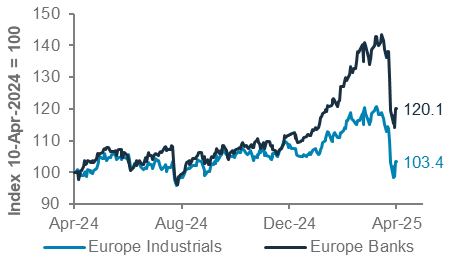
In China, non-financial high dividend SOEs have domestic exposure, while Hang Seng tech index benefits from AI development and stimulus plans
Performance of non-financial high dividend SOEs and Hang Seng tech index
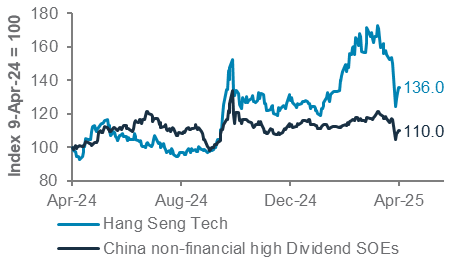
Source: Bloomberg, Standard Chartered
Top client questions (cont’d)
Are there any concerns on Alternative strategies amid the tariff-induced equities sell-off?
Alternatives have proven to be a relative safe-haven amid the recent sell-off. Liquid strategies posted small losses compared to the double-digit declines in equities. They better weathered recent volatility due to lower correlation with traditional assets. However, investors should bear in mind that, while hedge funds have shown resilience, some liquid strategies may struggle to perform during heightened volatility. Leverage, which is commonly employed by hedge funds, can magnify losses during market downturns, as margin calls and forced liquidity exacerbate selling pressure.
While valuations are not marked-to-market as frequently, private strategies are not immune to drawdowns in listed markets. The biggest risk to any strategy, whether public or private, is a significant deterioration in economic cycle, where reduced spending can lead to declining revenue, making it difficult for companies to service their debt obligations and reduced asset valuations. This can impact or delay exit strategies, delaying returns for investors.
However, managers can also take advantage of opportunities that may arise during public markets volatility. For example, attractive lending opportunities could surface when credit markets seize up. The excess returns of private equity also tend to be highest when public equity market volatility is high, as managers capitalise on inefficiencies, through active management and acquiring assets at lower prices. In essence, alternatives continue to have a strategic role in portfolios for both diversification and long-term growth.
— Audrey Goh, Head of Asset Allocation
Alternative strategies have held up better relative to global equities amid heightened volatility
Performance of Private Equity, Private Real Estate, Private Debt and Global Equities during past market crisis
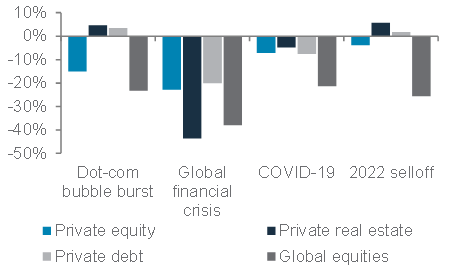
Source: Bloomberg, Standard Chartered
Top client questions (cont’d)
How can I protect my portfolio?
Amid concerns of a US-centric slowdown and rising stagflation risks, traditional US safe-haven assets like long-dated US government bonds and the US dollar have thus far offered limited protection against portfolio losses. Gold has, meanwhile, come under pressure as investors liquidated positions to meet equity margin calls amid the widespread equity market sell-off. We continue to be overweight gold and see the current weakness as an opportunity to add exposure, although we acknowledge gold has historically been vulnerable to forced liquidation when weekly losses in US equities have exceeded 8%.
To better hedge against further portfolio losses, we favour instead short-dated US government bonds, which more closely track market expectations of Fed policy and could thus better serve as a hedge against a slowdown in US economic conditions. German government bonds also offer protection, with Europe less exposed to tariff-driven inflation and the ECB likely to cut interest rates by another 25bps over the next 12 months.
Among currencies, the Japanese yen and Swiss franc have proven to be the most effective safe-havens. While the CHF has advanced the most amid the sell-off in risk assets, we prefer the JPY given expectations of further BoJ rate hikes. The CHF, meanwhile, is susceptible to possible SNB intervention as recent gains depress import costs and raise deflation risks.
While defensive equity sectors in Developed Markets have offered little protection, India’s consumer staples sector has notably shown resilience. US tariffs on India have been milder than expected and valuations are more reasonable following recent corrections. Along with a large domestic consumer market, India is also a likely beneficial of any investor outflows from China as US-China trade tensions intensify.
— Tay Qi Xiu, Portfolio Strategist
Gold is less effective as a hedge during extreme market losses
All S&P 500 weekly returns exceeding 8% and associated gold returns since 2000
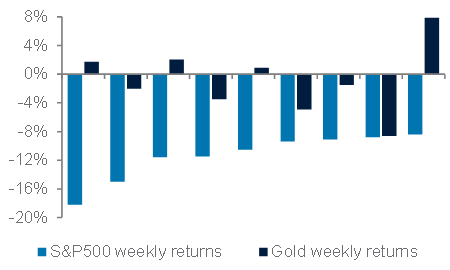
Source: Bloomberg, Standard Chartered
JPY, short-dated US Treasuries and Cash are potential safe-havens
Asset returns from 2nd April to 8th April 2025
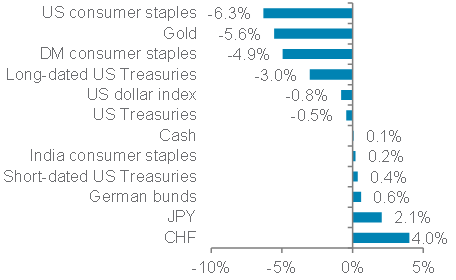
Source: Bloomberg, Standard Chartered
Top client questions (cont’d)
Why are you adding an inflation-protected bonds trade idea?
We are opening a new opportunistic idea on US Treasury Inflation-Protected bonds (‘TIPS’).
In recent days, a lot of focus has been on the growth-negative impact of US tariffs. However, there has been relatively little focus on the inflationary risks of a higher tariff world. Inflation swap markets and inflation-protected bond markets are reflecting higher inflation risks in short-term (1-year) expectations, but long-term (5-10-year) expectations remain moderate. This is in contrast to University of Michigan consumer sentiment survey data which earlier showed a sharp rise in 5-10 year inflation expectations. We see upside risk to longer-term inflation expectations from current levels amid three possible scenarios: (i) US tariffs ultimately stabilise at a high average level, (ii) trade deals lower the average tariff level, but these are counterbalanced by stronger growth, or (iii) a jump in oil prices (due to geopolitics, for example). Hence, we believe risk/reward favours adding US TIPS bonds as an opportunistic idea, which we also expect to outperform regular US government bonds.
— Manpreet Gill, Chief Investment Officer, AMEE
US consumer inflation expectations surged in March amid trade policy uncertainty
University of Michigan: expected change in prices during the next 5-10yr
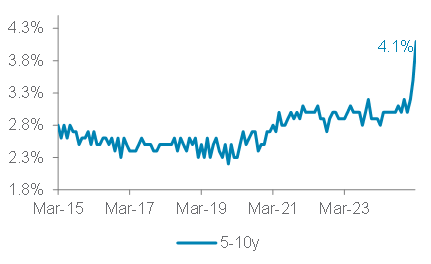
Source: Bloomberg, Standard Chartered
Market performance summary*
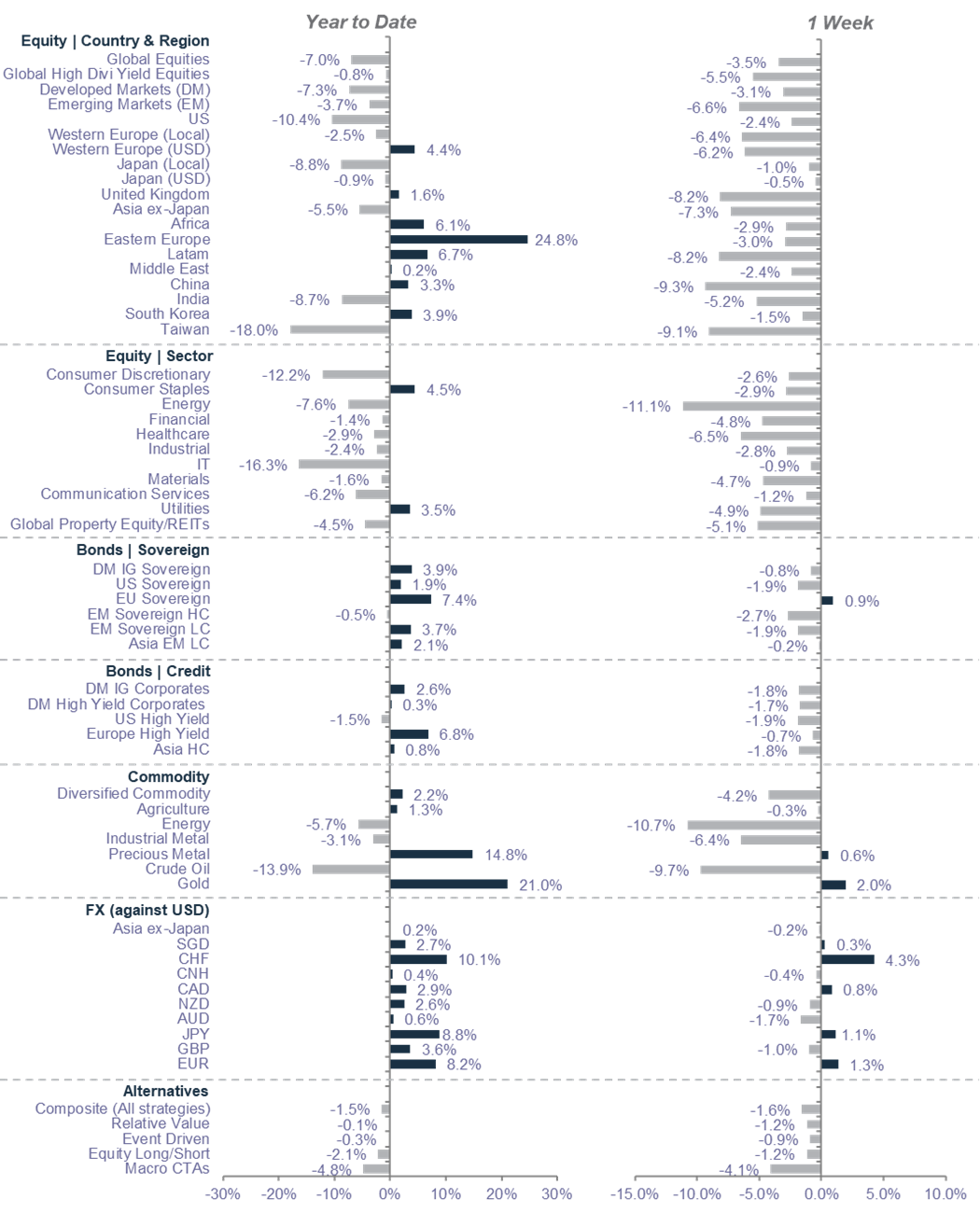
Sources: MSCI, JP Morgan, Barclays Capital, Citigroup, Dow Jones, HFRX, FTSE, Bloomberg, Standard Chartered. *Performance in USD terms unless otherwise stated, 2025 YTD performance from 31 Dec 2024 – 10 Apr 2025; 1-week period: 3-10 Apr 2025
Our 12-month asset class views at a glance
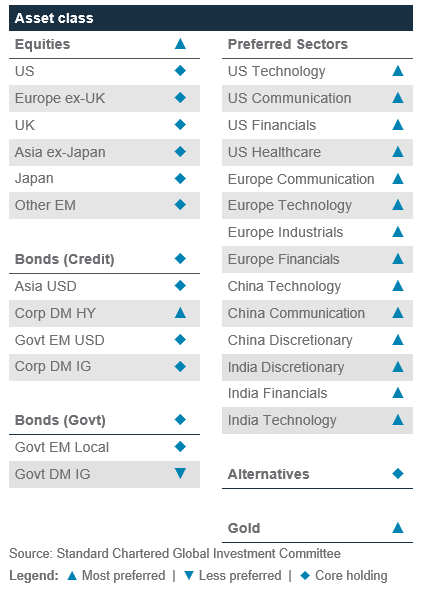
Economic and market calendar
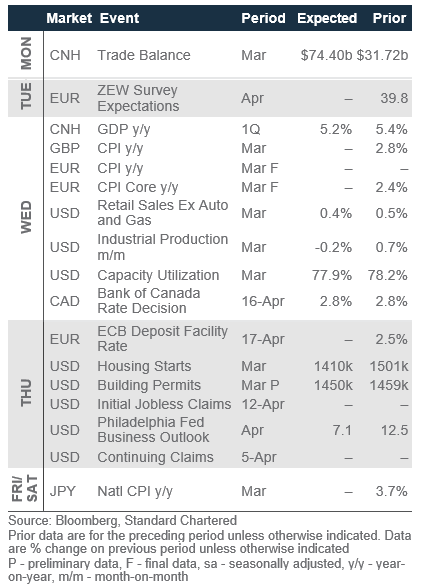
The S&P500 has next interim support at 4,806
Technical indicators for key markets as of 10 Apr close

Investor diversity in gold and EUR fell below key threshold
Our proprietary market diversity indicators as of 10 Apr close


Disclosure
This document is confidential and may also be privileged. If you are not the intended recipient, please destroy all copies and notify the sender immediately. This document is being distributed for general information only and is subject to the relevant disclaimers available at our Standard Chartered website under Regulatory disclosures. It is not and does not constitute research material, independent research, an offer, recommendation or solicitation to enter into any transaction or adopt any hedging, trading or investment strategy, in relation to any securities or other financial instruments. This document is for general evaluation only. It does not take into account the specific investment objectives, financial situation or particular needs of any particular person or class of persons and it has not been prepared for any particular person or class of persons. You should not rely on any contents of this document in making any investment decisions. Before making any investment, you should carefully read the relevant offering documents and seek independent legal, tax and regulatory advice. In particular, we recommend you to seek advice regarding the suitability of the investment product, taking into account your specific investment objectives, financial situation or particular needs, before you make a commitment to purchase the investment product. Opinions, projections and estimates are solely those of SC at the date of this document and subject to change without notice. Past performance is not indicative of future results and no representation or warranty is made regarding future performance. The value of investments, and the income from them, can go down as well as up, and you may not recover the amount of your original investment. You are not certain to make a profit and may lose money. Any forecast contained herein as to likely future movements in rates or prices or likely future events or occurrences constitutes an opinion only and is not indicative of actual future movements in rates or prices or actual future events or occurrences (as the case may be). This document must not be forwarded or otherwise made available to any other person without the express written consent of the Standard Chartered Group (as defined below). Standard Chartered Bank is incorporated in England with limited liability by Royal Charter 1853 Reference Number ZC18. The Principal Office of the Company is situated in England at 1 Basinghall Avenue, London, EC2V 5DD. Standard Chartered Bank is authorised by the Prudential Regulation Authority and regulated by the Financial Conduct Authority and Prudential Regulation Authority. Standard Chartered PLC, the ultimate parent company of Standard Chartered Bank, together with its subsidiaries and affiliates (including each branch or representative office), form the Standard Chartered Group. Standard Chartered Private Bank is the private banking division of Standard Chartered. Private banking activities may be carried out internationally by different legal entities and affiliates within the Standard Chartered Group (each an “SC Group Entity”) according to local regulatory requirements. Not all products and services are provided by all branches, subsidiaries and affiliates within the Standard Chartered Group. Some of the SC Group Entities only act as representatives of Standard Chartered Private Bank and may not be able to offer products and services or offer advice to clients.
Copyright © 2025, Accounting Research & Analytics, LLC d/b/a CFRA (and its affiliates, as applicable). Reproduction of content provided by CFRA in any form is prohibited except with the prior written permission of CFRA. CFRA content is not investment advice and a reference to or observation concerning a security or investment provided in the CFRA SERVICES is not a recommendation to buy, sell or hold such investment or security or make any other investment decisions. The CFRA content contains opinions of CFRA based upon publicly-available information that CFRA believes to be reliable and the opinions are subject to change without notice. This analysis has not been submitted to, nor received approval from, the United States Securities and Exchange Commission or any other regulatory body. While CFRA exercised due care in compiling this analysis, CFRA, ITS THIRD-PARTY SUPPLIERS, AND ALL RELATED ENTITIES SPECIFICALLY DISCLAIM ALL WARRANTIES, EXPRESS OR IMPLIED, INCLUDING, BUT NOT LIMITED TO, ANY WARRANTIES OF MERCHANTABILITY OR FITNESS FOR A PARTICULAR PURPOSE OR USE, to the full extent permitted by law, regarding the accuracy, completeness, or usefulness of this information and assumes no liability with respect to the consequences of relying on this information for investment or other purposes. No content provided by CFRA (including ratings, credit-related analyses and data, valuations, model, software or other application or output therefrom) or any part thereof may be modified, reverse engineered, reproduced or distributed in any form by any means, or stored in a database or retrieval system, without the prior written permission of CFRA, and such content shall not be used for any unlawful or unauthorized purposes. CFRA and any third-party providers, as well as their directors, officers, shareholders, employees or agents do not guarantee the accuracy, completeness, timeliness or availability of such content. In no event shall CFRA, its affiliates, or their third-party suppliers be liable for any direct, indirect, special, or consequential damages, costs, expenses, legal fees, or losses (including lost income or lost profit and opportunity costs) in connection with a subscriber’s, subscriber’s customer’s, or other’s use of CFRA’s content.
Market Abuse Regulation (MAR) Disclaimer
Banking activities may be carried out internationally by different branches, subsidiaries and affiliates within the Standard Chartered Group according to local regulatory requirements. Opinions may contain outright “buy”, “sell”, “hold” or other opinions. The time horizon of this opinion is dependent on prevailing market conditions and there is no planned frequency for updates to the opinion. This opinion is not independent of Standard Chartered Group’s trading strategies or positions. Standard Chartered Group and/or its affiliates or its respective officers, directors, employee benefit programmes or employees, including persons involved in the preparation or issuance of this document may at any time, to the extent permitted by applicable law and/or regulation, be long or short any securities or financial instruments referred to in this document or have material interest in any such securities or related investments. Therefore, it is possible, and you should assume, that Standard Chartered Group has a material interest in one or more of the financial instruments mentioned herein. Please refer to our Standard Chartered website under Regulatory disclosures for more detailed disclosures, including past opinions/ recommendations in the last 12 months and conflict of interests, as well as disclaimers. A covering strategist may have a financial interest in the debt or equity securities of this company/issuer. All covering strategist are licensed to provide investment recommendations under Monetary Authority of Singapore or Hong Kong Monetary Authority. This document must not be forwarded or otherwise made available to any other person without the express written consent of Standard Chartered Group.
Sustainable Investments
Any ESG data used or referred to has been provided by Morningstar, Sustainalytics, MSCI or Bloomberg. Refer to 1) Morningstar website under Sustainable Investing, 2) Sustainalytics website under ESG Risk Ratings, 3) MCSI website under ESG Business Involvement Screening Research and 4) Bloomberg green, social & sustainability bonds guide for more information. The ESG data is as at the date of publication based on data provided, is for informational purpose only and is not warranted to be complete, timely, accurate or suitable for a particular purpose, and it may be subject to change. Sustainable Investments (SI): This refers to funds that have been classified as ‘Sustainable Investments’ by Morningstar. SI funds have explicitly stated in their prospectus and regulatory filings that they either incorporate ESG factors into the investment process or have a thematic focus on the environment, gender diversity, low carbon, renewable energy, water or community development. For equity, it refers to shares/stocks issued by companies with Sustainalytics ESG Risk Rating of Low/Negligible. For bonds, it refers to debt instruments issued by issuers with Sustainalytics ESG Risk Rating of Low/Negligible, and/or those being certified green, social, sustainable bonds by Bloomberg. For structured products, it refers to products that are issued by any issuer who has a Sustainable Finance framework that aligns with Standard Chartered’s Green and Sustainable Product Framework, with underlying assets that are part of the Sustainable Investment universe or separately approved by Standard Chartered’s Sustainable Finance Governance Committee. Sustainalytics ESG risk ratings shown are factual and are not an indicator that the product is classified or marketed as “green”, “sustainable” or similar under any particular classification system or framework.
Country/Market Specific Disclosures
Botswana: This document is being distributed in Botswana by, and is attributable to, Standard Chartered Bank Botswana Limited which is a financial institution licensed under the Section 6 of the Banking Act CAP 46.04 and is listed in the Botswana Stock Exchange. Brunei Darussalam: This document is being distributed in Brunei Darussalam by, and is attributable to, Standard Chartered Bank (Brunei Branch) | Registration Number RFC/61 and Standard Chartered Securities (B) Sdn Bhd | Registration Number RC20001003. Standard Chartered Bank is incorporated in England with limited liability by Royal Charter 1853 Reference Number ZC18. Standard Chartered Securities (B) Sdn Bhd is a limited liability company registered with the Registry of Companies with Registration Number RC20001003 and licensed by Brunei Darussalam Central Bank as a Capital Markets Service License Holder with License Number BDCB/R/CMU/S3-CL and it is authorised to conduct Islamic investment business through an Islamic window. China Mainland: This document is being distributed in China by, and is attributable to, Standard Chartered Bank (China) Limited which is mainly regulated by National Financial Regulatory Administration (NFRA), State Administration of Foreign Exchange (SAFE), and People’s Bank of China (PBOC). Hong Kong: In Hong Kong, this document, except for any portion advising on or facilitating any decision on futures contracts trading, is distributed by Standard Chartered Bank (Hong Kong) Limited (“SCBHK”), a subsidiary of Standard Chartered PLC. SCBHK has its registered address at 32/F, Standard Chartered Bank Building, 4-4A Des Voeux Road Central, Hong Kong and is regulated by the Hong Kong Monetary Authority and registered with the Securities and Futures Commission (“SFC”) to carry on Type 1 (dealing in securities), Type 4 (advising on securities), Type 6 (advising on corporate finance) and Type 9 (asset management) regulated activity under the Securities and Futures Ordinance (Cap. 571) (“SFO”) (CE No. AJI614). The contents of this document have not been reviewed by any regulatory authority in Hong Kong and you are advised to exercise caution in relation to any offer set out herein. If you are in doubt about any of the contents of this document, you should obtain independent professional advice. Any product named herein may not be offered or sold in Hong Kong by means of any document at any time other than to “professional investors” as defined in the SFO and any rules made under that ordinance. In addition, this document may not be issued or possessed for the purposes of issue, whether in Hong Kong or elsewhere, and any interests may not be disposed of, to any person unless such person is outside Hong Kong or is a “professional investor” as defined in the SFO and any rules made under that ordinance, or as otherwise may be permitted by that ordinance. In Hong Kong, Standard Chartered Private Bank is the private banking division of SCBHK, a subsidiary of Standard Chartered PLC. Ghana: Standard Chartered Bank Ghana Limited accepts no liability and will not be liable for any loss or damage arising directly or indirectly (including special, incidental or consequential loss or damage) from your use of these documents. Past performance is not indicative of future results and no representation or warranty is made regarding future performance. You should seek advice from a financial adviser on the suitability of an investment for you, taking into account these factors before making a commitment to invest in an investment. To unsubscribe from receiving further updates, please send an email to feedback.ghana@sc.com. Please do not reply to this email. Call our Priority Banking on 0302610750 for any questions or service queries. You are advised not to send any confidential and/or important information to Standard Chartered via e-mail, as Standard Chartered makes no representations or warranties as to the security or accuracy of any information transmitted via e-mail. Standard Chartered shall not be responsible for any loss or damage suffered by you arising from your decision to use e-mail to communicate with the Bank. India: This document is being distributed in India by Standard Chartered in its capacity as a distributor of mutual funds and referrer of any other third party financial products. Standard Chartered does not offer any ‘Investment Advice’ as defined in the Securities and Exchange Board of India (Investment Advisers) Regulations, 2013 or otherwise. Services/products related securities business offered by Standard Charted are not intended for any person, who is a resident of any jurisdiction, the laws of which imposes prohibition on soliciting the securities business in that jurisdiction without going through the registration requirements and/or prohibit the use of any information contained in this document. Indonesia: This document is being distributed in Indonesia by Standard Chartered Bank, Indonesia branch, which is a financial institution licensed and supervised by Otoritas Jasa Keuangan (Financial Service Authority) and Bank Indonesia. Jersey: In Jersey, Standard Chartered Private Bank is the Registered Business Name of the Jersey Branch of Standard Chartered Bank. The Jersey Branch of Standard Chartered Bank is regulated by the Jersey Financial Services Commission. Copies of the latest audited accounts of Standard Chartered Bank are available from its principal place of business in Jersey: PO Box 80, 15 Castle Street, St Helier, Jersey JE4 8PT. Standard Chartered Bank is incorporated in England with limited liability by Royal Charter in 1853 Reference Number ZC 18. The Principal Office of the Company is situated in England at 1 Basinghall Avenue, London, EC2V 5DD. Standard Chartered Bank is authorised by the Prudential Regulation Authority and regulated by the Financial Conduct Authority and Prudential Regulation Authority. The Jersey Branch of Standard Chartered Bank is also an authorised financial services provider under license number 44946 issued by the Financial Sector Conduct Authority of the Republic of South Africa. Jersey is not part of the United Kingdom and all business transacted with Standard Chartered Bank, Jersey Branch and other SC Group Entity outside of the United Kingdom, are not subject to some or any of the investor protection and compensation schemes available under United Kingdom law. Kenya: This document is being distributed in Kenya by and is attributable to Standard Chartered Bank Kenya Limited. Investment Products and Services are distributed by Standard Chartered Investment Services Limited, a wholly owned subsidiary of Standard Chartered Bank Kenya Limited that is licensed by the Capital Markets Authority in Kenya, as a Fund Manager. Standard Chartered Bank Kenya Limited is regulated by the Central Bank of Kenya. Malaysia: This document is being distributed in Malaysia by Standard Chartered Bank Malaysia Berhad (“SCBMB”). Recipients in Malaysia should contact SCBMB in relation to any matters arising from, or in connection with, this document. This document has not been reviewed by the Securities Commission Malaysia. The product lodgement, registration, submission or approval by the Securities Commission of Malaysia does not amount to nor indicate recommendation or endorsement of the product, service or promotional activity. Investment products are not deposits and are not obligations of, not guaranteed by, and not protected by SCBMB or any of the affiliates or subsidiaries, or by Perbadanan Insurans Deposit Malaysia, any government or insurance agency. Investment products are subject to investment risks, including the possible loss of the principal amount invested. SCBMB expressly disclaim any liability and responsibility for any loss arising directly or indirectly (including special, incidental or consequential loss or damage) arising from the financial losses of the Investment Products due to market condition. Nigeria: This document is being distributed in Nigeria by Standard Chartered Bank Nigeria Limited (SCB Nigeria), a bank duly licensed and regulated by the Central Bank of Nigeria. SCB Nigeria accepts no liability for any loss or damage arising directly or indirectly (including special, incidental or consequential loss or damage) from your use of these documents. You should seek advice from a financial adviser on the suitability of an investment for you, taking into account these factors before making a commitment to invest in an investment. To unsubscribe from receiving further updates, please send an email to clientcare.ng@sc.com requesting to be removed from our mailing list. Please do not reply to this email. Call our Priority Banking on 02 012772514 for any questions or service queries. SCB Nigeria shall not be responsible for any loss or damage arising from your decision to send confidential and/or important information to Standard Chartered via e-mail. SCB Nigeria makes no representations or warranties as to the security or accuracy of any information transmitted via e-mail. Pakistan: This document is being distributed in Pakistan by, and attributable to Standard Chartered Bank (Pakistan) Limited having its registered office at PO Box 5556, I.I Chundrigar Road Karachi, which is a banking company registered with State Bank of Pakistan under Banking Companies Ordinance 1962 and is also having licensed issued by Securities & Exchange Commission of Pakistan for Security Advisors. Standard Chartered Bank (Pakistan) Limited acts as a distributor of mutual funds and referrer of other third-party financial products. Singapore: This document is being distributed in Singapore by, and is attributable to, Standard Chartered Bank (Singapore) Limited (Registration No. 201224747C/ GST Group Registration No. MR-8500053-0, “SCBSL”). Recipients in Singapore should contact SCBSL in relation to any matters arising from, or in connection with, this document. SCBSL is an indirect wholly owned subsidiary of Standard Chartered Bank and is licensed to conduct banking business in Singapore under the Singapore Banking Act, 1970. Standard Chartered Private Bank is the private banking division of SCBSL. IN RELATION TO ANY SECURITY OR SECURITIES-BASED DERIVATIVES CONTRACT REFERRED TO IN THIS DOCUMENT, THIS DOCUMENT, TOGETHER WITH THE ISSUER DOCUMENTATION, SHALL BE DEEMED AN INFORMATION MEMORANDUM (AS DEFINED IN SECTION 275 OF THE SECURITIES AND FUTURES ACT, 2001 (“SFA”)). THIS DOCUMENT IS INTENDED FOR DISTRIBUTION TO ACCREDITED INVESTORS, AS DEFINED IN SECTION 4A(1)(a) OF THE SFA, OR ON THE BASIS THAT THE SECURITY OR SECURITIES-BASED DERIVATIVES CONTRACT MAY ONLY BE ACQUIRED AT A CONSIDERATION OF NOT LESS THAN S$200,000 (OR ITS EQUIVALENT IN A FOREIGN CURRENCY) FOR EACH TRANSACTION. Further, in relation to any security or securities-based derivatives contract, neither this document nor the Issuer Documentation has been registered as a prospectus with the Monetary Authority of Singapore under the SFA. Accordingly, this document and any other document or material in connection with the offer or sale, or invitation for subscription or purchase, of the product may not be circulated or distributed, nor may the product be offered or sold, or be made the subject of an invitation for subscription or purchase, whether directly or indirectly, to persons other than a relevant person pursuant to section 275(1) of the SFA, or any person pursuant to section 275(1A) of the SFA, and in accordance with the conditions specified in section 275 of the SFA, or pursuant to, and in accordance with the conditions of, any other applicable provision of the SFA. In relation to any collective investment schemes referred to in this document, this document is for general information purposes only and is not an offering document or prospectus (as defined in the SFA). This document is not, nor is it intended to be (i) an offer or solicitation of an offer to buy or sell any capital markets product; or (ii) an advertisement of an offer or intended offer of any capital markets product. Deposit Insurance Scheme: Singapore dollar deposits of non-bank depositors are insured by the Singapore Deposit Insurance Corporation, for up to S$100,000 in aggregate per depositor per Scheme member by law. Foreign currency deposits, dual currency investments, structured deposits and other investment products are not insured. This advertisement has not been reviewed by the Monetary Authority of Singapore. Taiwan: SC Group Entity or Standard Chartered Bank (Taiwan) Limited (“SCB (Taiwan)”) may be involved in the financial instruments contained herein or other related financial instruments. The author of this document may have discussed the information contained herein with other employees or agents of SC or SCB (Taiwan). The author and the above-mentioned employees of SC or SCB (Taiwan) may have taken related actions in respect of the information involved (including communication with customers of SC or SCB (Taiwan) as to the information contained herein). The opinions contained in this document may change, or differ from the opinions of employees of SC or SCB (Taiwan). SC and SCB (Taiwan) will not provide any notice of any changes to or differences between the above-mentioned opinions. This document may cover companies with which SC or SCB (Taiwan) seeks to do business at times and issuers of financial instruments. Therefore, investors should understand that the information contained herein may serve as specific purposes as a result of conflict of interests of SC or SCB (Taiwan). SC, SCB (Taiwan), the employees (including those who have discussions with the author) or customers of SC or SCB (Taiwan) may have an interest in the products, related financial instruments or related derivative financial products contained herein; invest in those products at various prices and on different market conditions; have different or conflicting interests in those products. The potential impacts include market makers’ related activities, such as dealing, investment, acting as agents, or performing financial or consulting services in relation to any of the products referred to in this document. UAE: DIFC – Standard Chartered Bank is incorporated in England with limited liability by Royal Charter 1853 Reference Number ZC18.The Principal Office of the Company is situated in England at 1 Basinghall Avenue, London, EC2V 5DD. Standard Chartered Bank is authorised by the Prudential Regulation Authority and regulated by the Financial Conduct Authority and Prudential Regulation Authority. Standard Chartered Bank, Dubai International Financial Centre having its offices at Dubai International Financial Centre, Building 1, Gate Precinct, P.O. Box 999, Dubai, UAE is a branch of Standard Chartered Bank and is regulated by the Dubai Financial Services Authority (“DFSA”). This document is intended for use only by Professional Clients and is not directed at Retail Clients as defined by the DFSA Rulebook. In the DIFC we are authorised to provide financial services only to clients who qualify as Professional Clients and Market Counterparties and not to Retail Clients. As a Professional Client you will not be given the higher retail client protection and compensation rights and if you use your right to be classified as a Retail Client we will be unable to provide financial services and products to you as we do not hold the required license to undertake such activities. For Islamic transactions, we are acting under the supervision of our Shariah Supervisory Committee. Relevant information on our Shariah Supervisory Committee is currently available on the Standard Chartered Bank website in the Islamic banking section. For residents of the UAE – Standard Chartered Bank UAE does not provide financial analysis or consultation services in or into the UAE within the meaning of UAE Securities and Commodities Authority Decision No. 48/r of 2008 concerning financial consultation and financial analysis. Uganda: Our Investment products and services are distributed by Standard Chartered Bank Uganda Limited, which is licensed by the Capital Markets Authority as an investment adviser. United Kingdom: In the UK, Standard Chartered Bank is authorised by the Prudential Regulation Authority and regulated by the Financial Conduct Authority and Prudential Regulation Authority. This communication has been approved by Standard Chartered Bank for the purposes of Section 21 (2) (b) of the United Kingdom’s Financial Services and Markets Act 2000 (“FSMA”) as amended in 2010 and 2012 only. Standard Chartered Bank (trading as Standard Chartered Private Bank) is also an authorised financial services provider (license number 45747) in terms of the South African Financial Advisory and Intermediary Services Act, 2002. The Materials have not been prepared in accordance with UK legal requirements designed to promote the independence of investment research, and that it is not subject to any prohibition on dealing ahead of the dissemination of investment research. Vietnam: This document is being distributed in Vietnam by, and is attributable to, Standard Chartered Bank (Vietnam) Limited which is mainly regulated by State Bank of Vietnam (SBV). Recipients in Vietnam should contact Standard Chartered Bank (Vietnam) Limited for any queries regarding any content of this document. Zambia: This document is distributed by Standard Chartered Bank Zambia Plc, a company incorporated in Zambia and registered as a commercial bank and licensed by the Bank of Zambia under the Banking and Financial Services Act Chapter 387 of the Laws of Zambia.
